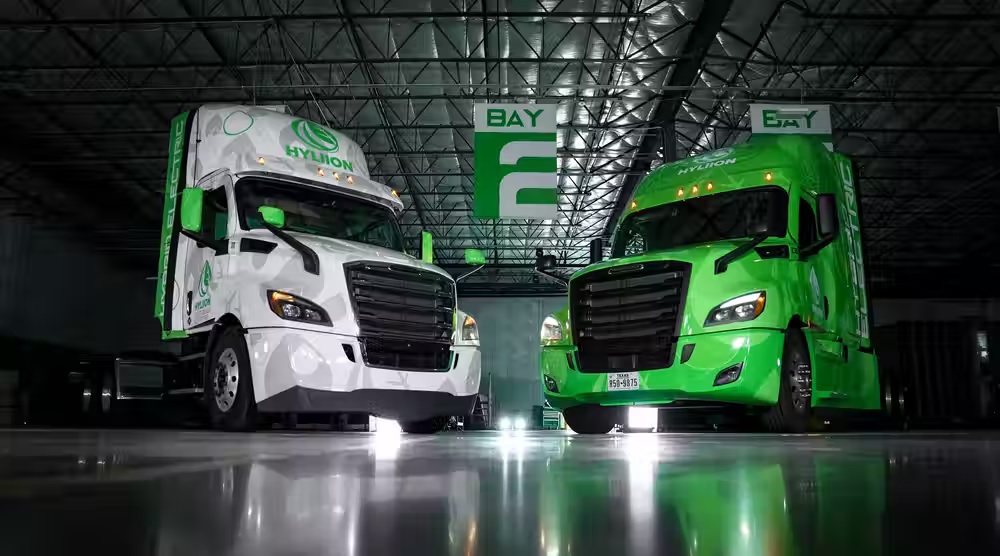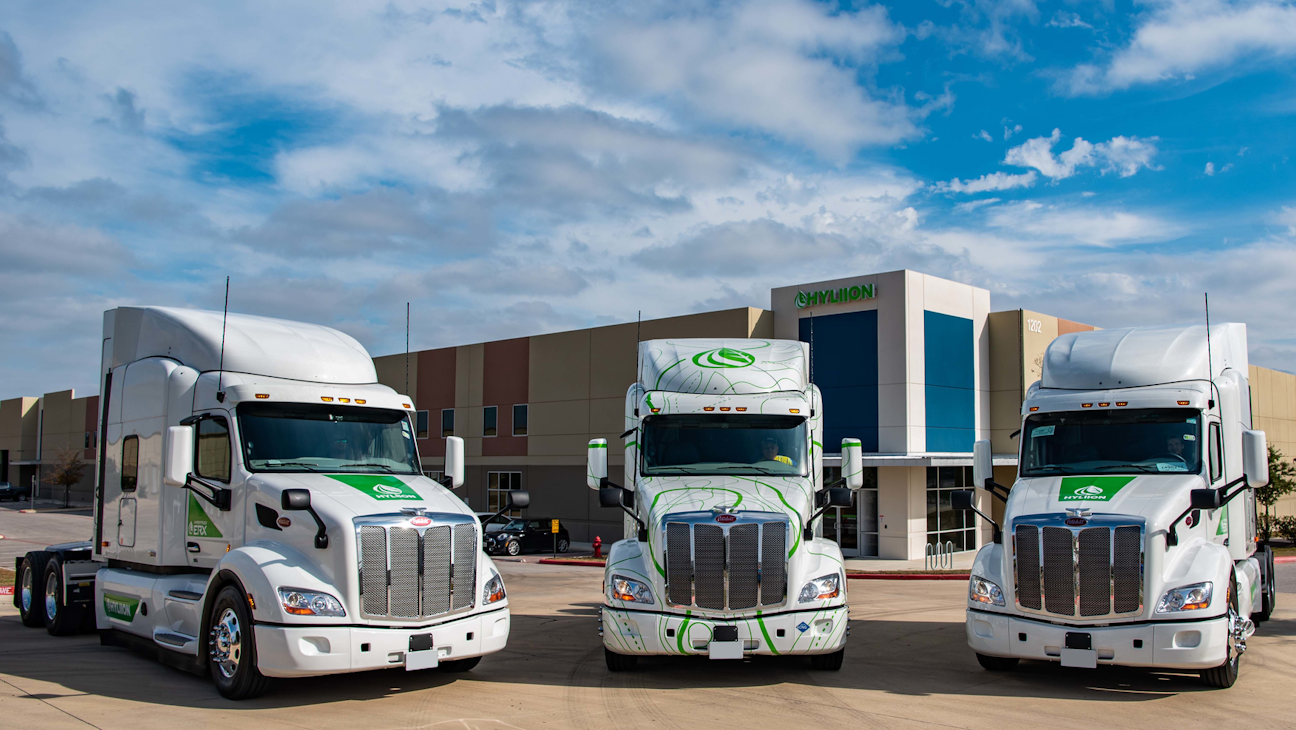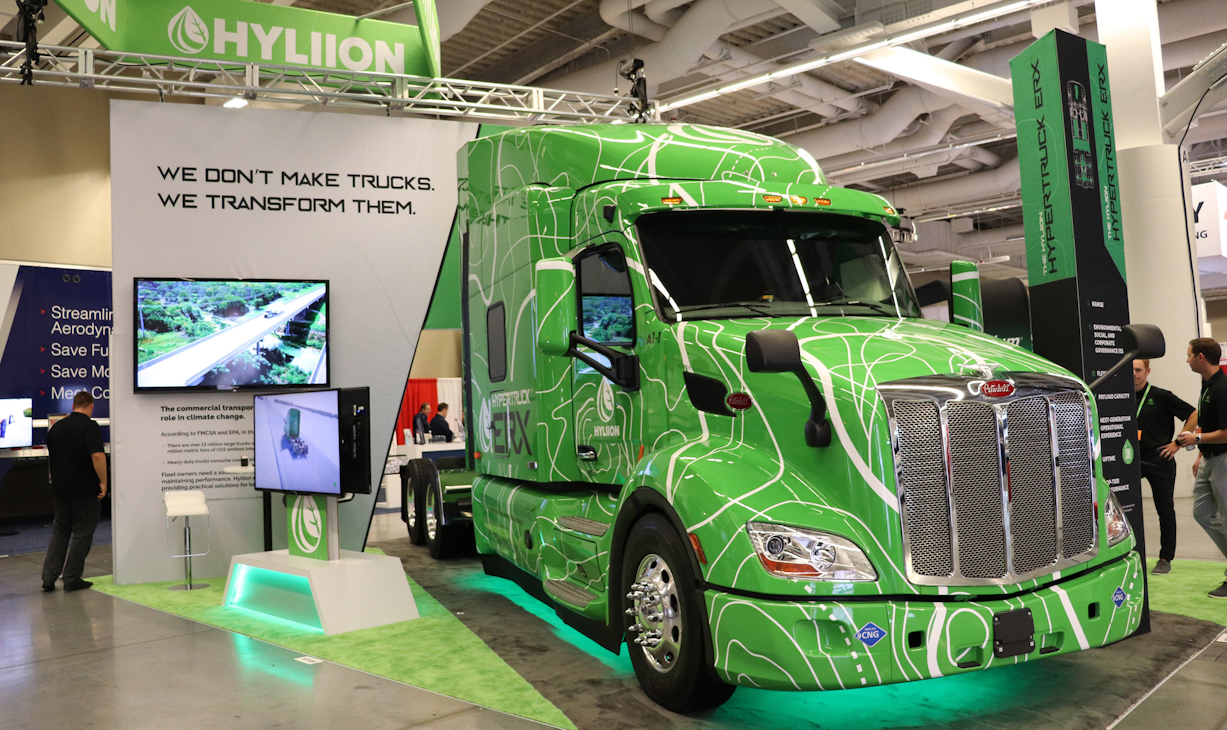As the industry continues to announce and reveal electrified vehicle solutions and technologies, fleets must contend with finding solutions that fit their operations efficiently. There are many questions fleets bring to the electrification discussion, such as when to adopt and for what applications. What to do about charging infrastructure and what duty cycles make sense for battery-electric vehicles (BEVs) are two other big ones.
Today, fully battery-electric trucks are range-limited, offering less than 300 miles per charge, so one powertrain manufacturer seeking to own a chunk of the market, Hyliion, chose to offer a different approach.
The Hypertruck ERX (electric range extender) generates its own electricity from compressed natural gas for a range of nearly 1,000 miles. Kenworth tried and abandoned a similar concept with the T680.
The lighter Hybrid eX solution drops an electric axle onto a diesel or CNG truck’s chassis to reap the benefits of electrification, such as regenerative braking and less powertrain maintenance. Cummins and Navistar unsuccessfully tried that over a decade ago.
But the future is not yet written, so Fleet Maintenance spoke with Hyliion Founder and CEO Thomas Healy to gain some insights into how the company fits into the current electric landscape, and how hydrogen may power its longterm success.
[Edited for length and clarity]
Fleet Maintenance: Can you tell us about Hyliion and your journey into hybrid electrification?
Thomas Healy: Electrifying trucking has been the mission of Hyliion since day one. We wanted to find ways that we can come in and provide emission reduction technology—coupling that with a cost-saving technology as well—in order to get fleets to move over to electrification.
When we looked at this landscape, we asked, ‘Well, does it make sense to become an OEM to make an entire vehicle? Or does it make sense to become a powertrain company where we have the ability to work with all the OEMs? And then, we can let fleets adopt our solutions, but do it on a platform and a chassis that they already know and love.’
That’s why Hyliion is focused on the powertrain. We can bring forward electrified solutions in that capacity and do it in an expedient and low capital way compared to building a whole truck.
I think every fleet is excited about electrification, but they’re really trying to figure out what solution is going to be right for them. There are two different parts of the market: BEV plug-in and electric range extender vehicles.
With BEV, you drive a couple hundred miles, come back, plug it in, and charge it overnight. Range extenders, though, are fully electric-drive vehicles, but you have an onboard generator in order to recharge the batteries. The question after that is what fuel to use: natural gas or hydrogen?
BEV plug-in makes a ton of sense for a small part of the market—those that are driving 100 miles a day, the truck gets domiciled at one location. For the rest of the market, the fleets that are driving 400, 500, or more miles than that a day, you really need a range-extender solution.
We created a roadmap where we’re able to start with natural gas today, then we can evolve into hydrogen as we go forward.
FM: What should fleets look at while deciding which electrification model to adopt?
TH: Fleets are really going to look at the emissions profile of the truck, the cost of operation, and the existing infrastructure to run the vehicle.
Infrastructure is probably the biggest hurdle with electrification. That’s the toughest part. If you’re going to BEV plug-in, you need charging pedestals. You also need a lot of upgrades to the grid to even be able to support that charging pedestal.
With hydrogen, hydrogen stations aren’t out there yet today. They will be at some point in the future. It’s tough to know when, but that’s where we see natural gas—that already has 700 stations built out across the U.S.—as being a very viable, very available solution that we can start with.
When we look at the actual cost of operations, we found natural gas is about one-third the price of diesel fuel today. It’s a pretty inexpensive, low-cost fuel source. Comparatively, hydrogen is often multiples of the cost of diesel. And then electricity, it obviously varies where you’re sourcing it, but it usually is also going to be more expensive than diesel as well. As an example, if a fleet buys diesel fuel at $3 per gallon, and they get 7.5 mpg, then they are spending $0.40 on fuel per mile. With electric, your electricity cost per mile is equal to your electricity grid cost which often has peak usage fees associated. We recently spoke with one group who expressed their peak electricity pricing is $0.25 per kWh, which comes to about $0.63 per mile.
While all electric vehicles are going to cost more than diesel trucks, if you use a fuel source that costs less than diesel, you have an ability to make this a positive ROI for the fleet. If you use a fuel that’s more, you don’t have that opportunity. And that’s where we see natural gas having the advantages there.
On the emissions side of things, there are so many misconceptions. We like to look at emissions from well to wheel. Where did your electricity come from? What are the emissions that are associated with that? A lot of our grid electricity is coming from coal-fired power plants, natural gas power plants, some coming from wind and solar, and nuclear as well. But a lot of the different sources have emissions associated with it.
When we use natural gas, we have the ability to use renewable natural gas, and you can drive net carbon-negative or below-zero emissions profiles. CARB (California Air Resources Board) did a study where they looked at carbon intensity (CI) scores, and they found that the CI score of grid electricity in California is in the low 80s. The CI score of conventional fracked natural gas is in the high 70s. With RNG, you can get all the way down to a -350 CI score. There is a huge opportunity for emissions savings when using RNG.
FM: What are the major differences between the Hybrid eX and the Hypertruck ERX?
TH: The best way to think about the Hybrid eX is that it’s like taking your semi-truck and making it like a large Toyota Prius—a very large Toyota Prius. You still have your diesel or natural gas powertrain. Then we replace one of the axles on the truck with an e-axle that can apply power, apply torque, and can also do regen braking to charge the batteries. It never needs to be plugged in, and you’re using your conventional vehicle.
This is a supplemental powertrain and a great solution to move into electrification at a very low risk and relatively low cost. We found that for fleets that want to focus on ESG (Environmental, Social and Governance) and get into electrification, it is a perfect steppingstone.
The ‘end all, be all’ is full electric-drive vehicles, and that’s where the Hypertruck ERX comes into play. It has a full electric-drive powertrain but uses onboard natural gas to recharge the batteries. And we’ll evolve the generator on the truck eventually to a hydrogen-based solution. We’re positioned so that as infrastructure gets built out, as cost of hydrogen comes down, we’ll move over when the time’s right. But it starts today with natural gas as a really smart solution.
We are already shipping Hybrid eX products to fleets. It’s at low volumes, but we’re getting them out there. We already have millions of miles logged—real road-worthy miles. And that’s been invaluable for Hyliion because getting electric solutions out there isn’t easy. There’s a lot of new things to work through with fleets, and we’ve already checked a lot of those boxes. As we go into later this year, we’re going to start controlled fleet trials with the Hypertruck ERX. You’ll see them in fleet operations moving freight later this year.
FM: And what applications or duty cycles are best suited for the Hybrid eX and the Hypertruck ERX?
TH: For the Hybrid eX system, we find that hilly terrain areas are the best. The Appalachian Mountain area, Rocky Mountain area—really, where there’s an ability for our e-axle to do regen braking to recharge the batteries. To do that, you need a downhill slope, then when you hit the uphill is when the e-axle kicks in and gives you some power boost. That is where we’re focusing the Hybrid product.
But we see the Hypertruck ERX as being applicable for most of the applications in the U.S. Now, as mentioned before, we see that BEV plug-in makes a lot of sense for short haul, local delivery in city-type applications. The Hypertruck ERX is more for the long-haul, over-the-road-type applications—but it is not terrain dependent. So, flat terrain, rolling hills, very hilly—it checks the boxes on all those. And natural gas stations are widely available across the U.S.
The Hypertruck ERX has over 1,000 miles of range when you get a full tank of natural gas with the battery pack. On most [long haul] routes, you’re going to pass a handful of stations that you could refuel at, and it only takes you 10 minutes to refuel.
FM: What do fleet maintenance departments only familiar with diesel need to know about servicing CNG systems?
TH: If you’re just doing brake changes or tire changes, there really is no difference. You just turn the master switch of natural gas off and you’re good to go.
If you’re getting into fuel system overhauls and things like that, you do need to have a facility that is able to work on natural gas trucks. There are facilities spread out across the U.S.; they’re out there. But it is not capital-intensive in order for a fleet to upgrade their facility to be able to do that.
If you need work done on the actual fuel system, you’re going to bring that to a qualified dealer. For the normal truck maintenance, it’s really the same.
FM: Are there other maintenance considerations when working on Hyliion solutions, such as dealing with high voltages?
TH: One of the things we often get a question on is, ‘What about electrification? Do I need to train all my technicians on how to work on batteries?’
In our approach, we’ve kept everything that is high voltage pretty much isolated so that a technician never has to deal with that. For instance, a battery may fail out in the field. We’ve designed to do a full battery pack swap as opposed to having a technician opening up the battery and getting close to the cells. From that standpoint, we don’t need to train people on how to deal with high-voltage battery packs. It’s more nuts and bolts of how you unbolt the battery, bolt the new one up, and then reconnect the wires.
The routine maintenance on our systems are things like glycol changes, topping it off, or doing a flush of the antifreeze, very similar to what a truck normally goes through today.
FM: How do these hybrid-electric powertrains affect wear items and PM schedules?
TH: In the beginning, there are always new learnings. There are always things that don’t go as expected, and we’ve been faced with that as well. Right now, we keep more of a white-glove, hands-on approach with these vehicles just to ensure that we get any of the bugs worked out of them.
As for the future, Tesla is a great example. You don’t have a scheduled maintenance cycle; you only bring this vehicle in for service if something fails on the vehicle.
We want to adopt that sort of a solution or something similar—maybe not quite to that extent, but to where for any routine maintenance, we schedule that in when that truck is already down for a normal PM. And we don’t envision that fleets, in the long term, will need dedicated PMs just for the electric system.
The one caveat there is if you are getting components to their end of life. For instance, one of the big concerns with the BEV plug-in vehicles is how long the batteries are going to last. And it might be that at 500,000 miles or 300,000 miles, you need to change the battery pack on a BEV plug-in.
Our systems are a little different, where a BEV plug-in is trying to charge the batteries all the way up and then deplete them all the way down, and do that daily.
With our solution, we have the batteries running in the middle, and we’re constantly charging them as we go down the road. We found that we get a lot longer life out of our battery pack. We expect our battery solutions to be able to last the life of the vehicle and not need to be replaced.
The way to think about a range extender vehicle is you have a generator under the hood that is producing electricity, but you want to keep that operating at its absolute sweet spot.
With a normal diesel truck today, if you climb a hill, that rpm of the engine is spiking up, your driver is downshifting, and you’re going to consume a ton of fuel during that period. The flip side of that is you’re coasting down a hill, the engine is still running, and you’re not producing any power, but you’re still consuming fuel.
The generator always operates at a nominal, peak performance. When you hit an uphill, when you need a bunch of power, it’s going to pull that excess power out of your battery pack. When you get back to flat terrain, you’re going to be pulling most of your power from the generator. When you’re going downhill, your generator is going to be charging the batteries, and you’re going to be in a coast-mode, or maybe even a regen mode where the e-axles are charging the batteries as well.
From that standpoint, the load put on the generator is much less than what goes to a diesel truck because it has that battery as a buffer.
Source: https://www.fleetmaintenance.com/








